Where: Outside over the main road, in a graveyard, outside a hotel, inside a newly refurbished museum and in a moving car.
When: Mainly at night, although I had seen a number of press and news images of the galleries of the refurbished museum and I knew that they would be suitable at any time of the day.
How: I used a number of setups ; Over the main road I had the camera mounted on a tripod with the head locked off. In the Graveyard I again used the tripod. Inside the museum I stuck to the brief and just hand held the camera. Inside the car I used a combination of hand held and a Delkin “Fat Gecko” suction mounted tripod (See http://delkin.com/i-5829837-fat-gecko-original-dual-suction-camera-mount.html) for more details on the mount.
I had also done a little extra research into photographing neon lights at http://www.popphoto.com/how-to/2010/10/how-to-shoot-neon-lights just in case I came across any but alas I did not.
Main Road
The position that I scouted is a bridge over a long dual carriageway which acts as the main road. I positioned myself in the middle of the bridge and waited for some traffic to arrive. Unexpectedly I found it to be quite a quiet time and I had to wait a while before I saw any traffic at all. I had set the camera to ISO 100 so that I would be able to obtain the light trails from the moving vehicles and I had also set the white balance to shade as it captured the hues to the best representation.
Car Headlights One
D80,Aperture f/4, Shutter Speed 4 sec, ISO 100, 18mm (35mm equivalent 27mm), Pattern Metering Mode, Shade White Balance, Tripod Mounted, 18-70mm lens

I was please to see that the sky had almost the same colours as it had before the sun set and that the green hue of the fields was nicely defined. I like the composition of the image as the lights attract your eye and then draw them off into the distance along the path of the road.
Car Headlights Two
D80,Aperture f/3.8, Shutter Speed 0.3 sec, ISO 100, 29mm (35mm equivalent 43mm), Pattern Metering Mode, Shade White Balance, Tripod Mounted, 18-70mm lens

I moved the camera over to the other side of the bridge which looked towards where the sun had set. I was surprised to find that there was still a lot of light in the sky and that I had to adjust the shutter speed to 0.3 of a second. While I achieved getting both the shape of the vehicle and the tail of the lights I find the final image a little on the dark side compared to the first image where the surrounding were light up more and the image composition was balanced more.
Car Headlights Three
D80,Aperture f/3.8, Shutter Speed 3 sec, ISO 100, 29mm (35mm equivalent 43mm), Pattern Metering Mode, Shade White Balance, Tripod Mounted, 18-70mm lens
I recomposed the image and waited a little longer for some traffic before taking this image. This time the colours and composition balance. I still was not happy and so took another image.
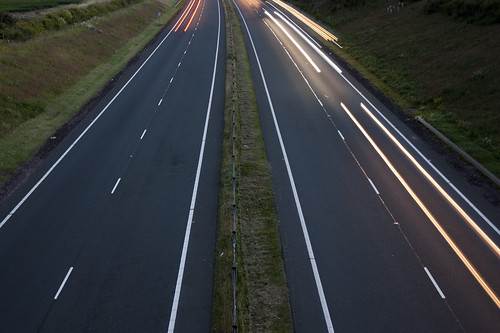
Car Headlights Four
D80,Aperture f/22, Shutter Speed 25 sec, ISO 100, 18mm (35mm equivalent 27mm), Pattern Metering Mode, Shade White Balance, Tripod Mounted, 18-70mm lens
I adjusted the aperture to f/22 as I wanted quite a long exposure time and I wanted to capture the sky and the surroundings of the road. As the aperture was at f/22 I made the shutter speed 25 seconds. This allowed me to wait on the slow moving tractor with its flashing amber beacon and allow it to move past.
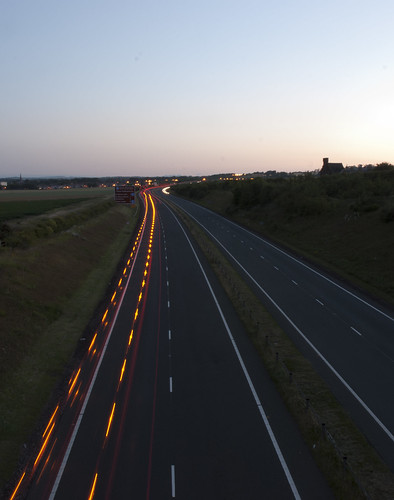
I am very happy with this final image as the dotted effect of the flashing amber beacon has created an unusual light trail and an unusual image.
Graveyard
Just as I was moving off the bridge I noted that the lights on the one floodlight building around were on. I took the first image from the edge of the bridge pointing down towards the building using a telephoto lens.
Church Light Up from a Distance
D80,Aperture f/22, Shutter Speed 3 sec, ISO 100, 270mm (35mm equivalent 405mm), Pattern Metering Mode, Shade White Balance, Tripod Mounted, 70-300mm VR lens

Again I like the way that it looks almost like daytime, the orange of the floodlights balances against the green of the fields and the blue of the sky.
Church Light Up One
I moved down into the graveyard beside the church and took this image of the building positioned at the edge of the path a little way in from the front gate. I had to move around to find a position where I could photograph the church without being blocked by a gravestone, a bush or a tree.
D80,Aperture f/22, Shutter Speed 30 sec, ISO 100, 40mm (35mm equivalent 60mm), Pattern Metering Mode, Fluorescent White Balance, Tripod Mounted, 18-70mm lens

I changed the white balance to fluorescent as I noted that the lights on the building were very orange close up and that if I had not adjusted the white balance I would have ended up with an over warm image where it would have been washed out by an orange hue. I like the colour of the sky as it is a dark midnight blue and at the same time I managed to capture the colours of the stain glass window and not allow it to be too over or under exposed.
Church Light Up Two
I moved outside the grounds to the church in an attempt to get another composition of the church and its lighting. In the end I positioned myself close to the ground and moved the tripod down to my level; from there I could photograph the tower of the church between the railings on the wall.
D80,Aperture f/27, Shutter Speed 10 sec, ISO 100, 70mm (35mm equivalent 105mm), Pattern Metering Mode, Fluorescent White Balance, Tripod Mounted, 18-70mm lens
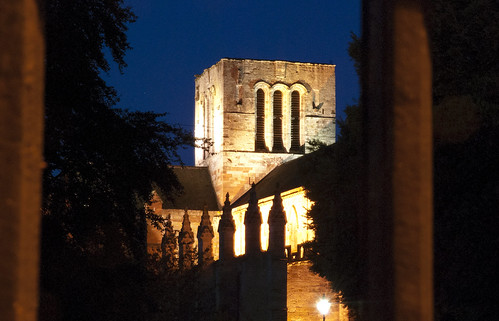
I then cropped the final image as I had too much dead space on the right of the frame which was detracting from the composition. At this angle I noted that the lights were less orange and whiter and that the lights from the church would silhouetted the trees on either side of the frame.
Hotel Light Up in Blue
Opposite the church is a hotel which was floodlight in blue. I moved to the very edge of the property and shot down the driveway and between the bushes that bordered the driveway. I noted that there was a combination of blue floodlights and yellow internal lights
D80, Aperture f/27, Shutter Speed 20 sec, ISO 100, 56mm (35mm equivalent 84mm), Pattern Metering Mode, Tungsten White Balance, Tripod Mounted, 18-70mm lens

I decided to use Tungsten white balance as I thought that the fluorescent white balance would create a very cold blue hue and I wanted to capture the warmth of the internal lights as well as the light blue hue of the floodlights. Examining the image later I can see that the lights almost split the building in two horizontally; the lower half being the warm orange of the internal decorations against the tungsten lights and the upper half being the colder blue of the floodlights. Again I was pleased to see that I had managed to get an exposure where I could balance the internal and the external lights and not over or under expose either.
Trees Light From Below
Just outside the hotel was a floodlight sign, and as I moved away from the building I could see that there was an overspill of light from the triangular shaped sign and that it was being reflected up into the tree leaves above the sign. I liked the differing colours caused by the spill of light so I set up the tripod across the road from the trees and shot up into the leaves.
D80, Aperture f/22, Shutter Speed 30 sec, ISO 100, 18mm (35mm equivalent 27mm), Pattern Metering Mode, Fluorescent White Balance, Tripod Mounted, 18-70mm lens
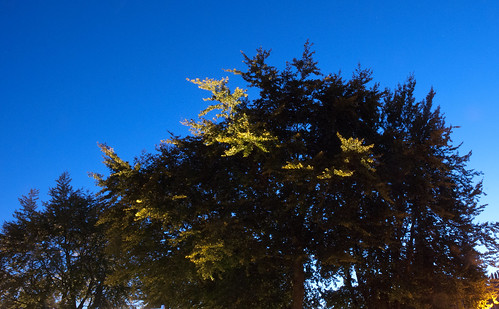
I then cropped the final image as I had managed to capture a orange street light in the composition. I like the composition of this image as it has both a silhouetted tree and the branches leaning out of the darkness into the bright light.
Street Light
As we parked up home again I decided to take an image of a street light, something which I had struggled with previously. While not strictly within the brief I wanted to see if I could capture the correct hue of light from the street light.
D80, Aperture f/4.5, Shutter Speed 1/6 sec, ISO 3200, 70mm (35mm equivalent 105mm), Pattern Metering Mode, Fluorescent White Balance, Tripod Mounted, 18-70mm lens

While it was better than I had managed before I think I could do better.
Moving Car
Due to my eye condition I do not like to drive at night as I almost have to have my eyes closed at times to protect them from the headlights of other vehicles. I noticed that if I squinted enough the all the street lights and other car lights just became blobs and streaks of light.
Having bought a Delkin mount to use with my previous car, I took it with me when Lindsay was driving me from location to location for this exercise. I mounted it on the passenger window and set the camera up so that I could capture light trails through the windscreen of the car.
Moving Car One.
D80, Aperture f/19, Shutter Speed 20 sec, ISO 100, 18mm (35mm equivalent 27mm), Pattern Metering Mode, Tungsten White Balance, Tripod Mounted, 18-70mm lens
I realised that the windscreen had a slight tint to it so I set the white balance to Tungsten as even today a lot of cars still use tungsten bulbs as their main source of light.
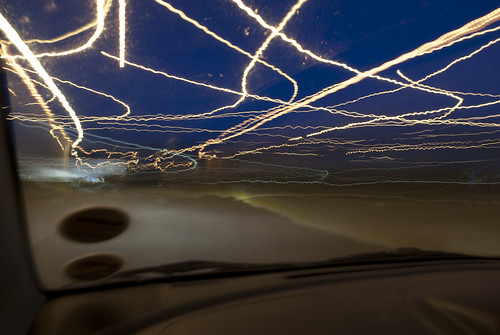
I am very pleased with this image as the light trails really do indicate the movement of the car from my position as a passenger. It is strange to see the many different hues and types of light used, as I managed to capture street lights, car lights, traffic lights and reflected light from buildings.
Moving Car Two
I decided to repeat the shot again, but moved the camera and mount to a different position closer to me in the car, so that I was practically looking out through the viewfinder as we moved.
This time as the camera was closer to me, it received a little more support and it did not vibrate as much. I wanted less of an exposure time so I adjusted the ISO to ISO1000 and set the shutter speed at 6 seconds.
D80, Aperture f/22, Shutter Speed 6 sec, ISO 1000, 18mm (35mm equivalent 27mm), Pattern Metering Mode, Fluorescent White Balance, Tripod Mounted, 18-70mm lens

Even though there are less light trails I like the sine wave that the movement of that the car set up as it moved over a rather uneven patch of road.
Inside the Museum
Having seen the refurbished museum on the news I decided that it would be ideal for this exercise as there were a number of locations inside the museum which now had no natural light at all.
On entering the museum I found the first location which was a vault like structure which was the ground floor storage area underneath the entrance to the museum.
It was very brightly lit to make it attractive and welcoming to visitors with a number of different lighting styles.
Looking at the colours of the stone and the setup of the lights I decided on tungsten white balance as otherwise the image would have a darker yellow hue to it which detracted from the beauty of the building.
D80, Aperture f/16, Shutter Speed 1/6 sec, ISO 3200, 18mm (35mm equivalent 27mm), Pattern Metering Mode, Tungsten White Balance, Hand Held, 18-70mm lens
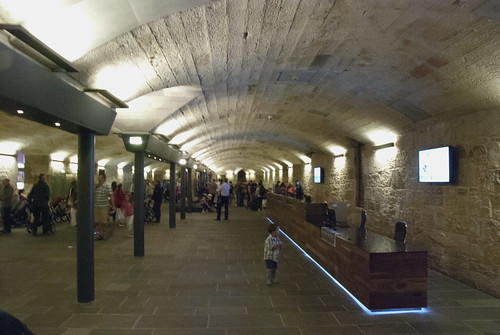
It was quite difficult to get a successful hand held shot in such low light conditions, I had to go to the maximum ISO on the camera to allow me to achieve hand held speeds.
Inside the Science Hall
I moved into the back of the museum where they have blocked off all the light coming in through the Victorian arched iron roof and due to the set up of the walls all natural light is blocked off from entering the hall. The main light for the hall comes from the walls and from the exhibition display cabinets.
D80, Aperture f/4.8, Shutter Speed 1/8 sec, ISO 3200, 18mm (35mm equivalent 27mm), Pattern Metering Mode, Fluorescent White Balance, Hand Held, 18-70mm lens

Inside the Science Hall Two
I recomposed the image just to capture the ground floor layout and the lights coming from the exhibition display cabinets only
D80, Aperture f/4.8, Shutter Speed 1/45 sec, ISO 3200, 18mm (35mm equivalent 27mm), Pattern Metering Mode, Fluorescent White Balance, Hand Held, 18-70mm lens

I noticed that there was a lot more light coming off the display cabinets as I needed a faster shutter speed although all I had done was point the camera directly into the room. I can also see that the exhibition display are not so over exposed and that you can now easily see what is in the cabinets.
Inside the Cultural Hall
I then moved up to the top of the museum and went into the cultural gallery where again like the science gallery the natural light has been removed by blocking up the windows and the roof. I wanted to capture the shape of the roof as well as the limited amount of light in the gallery
D80, Aperture f/4.8, Shutter Speed 1/15 sec, ISO 3200, 18mm (35mm equivalent 27mm), Pattern Metering Mode, Tungsten White Balance, Hand Held, 18-70mm lens

A lot of this area is light up using LED lighting which lends itself to tungsten white balance as depending on the colour of the LEDs it can produce a light which is almost the same colour temperature as tungsten.
Inside the Cultural Hall Two
Looking down into the crowded gallery below I noticed that there was a number of different light sources and that the light was coming from all directions. Again I went for tungsten white balance as it made for the best compromise in colour temperature for the whole gallery.
D80, Aperture f/4.8, Shutter Speed 1/15 sec, ISO 3200, 18mm (35mm equivalent 27mm), Pattern Metering Mode, Tungsten White Balance, Hand Held, 18-70mm lens
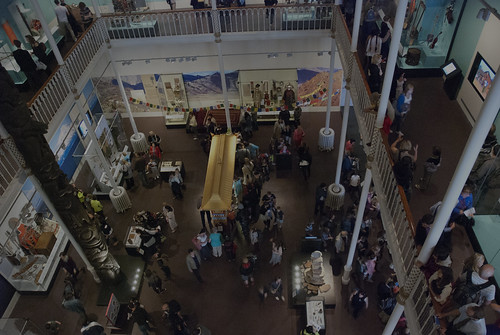
This has been quite a hard exercise to perform as I found it difficult to find the right lighting conditions for each circumstance. I took a number of images where the white balance did not work out, the shutter speed was incorrect causing over and under exposure.
I was really out of my comfort zone for many of these images as I had to go complete manual mode and at times work out in my head what would be the right exposure time for the image. I’m pleased to say that I did not panic and I just took a few extra seconds to work out what I wanted before setting the camera up.
Again I have learned that there is a great difference in the colouration of artificial light and that I can use the cameras white balance to correct the image where the final result would end up being too cold or to warm due to the tints and hue caused by the incorrect white balance. I was pleased to find that I could obtain the correct white balance through practice and that during the exercise I was able to set the correct white balance before taking an exposure.
What I was really pleased to find was that I was successful in obtaining a few images which although they had been taken after sunset still appeared as if they had been taken during the day; this was particularly pleasing as I have been trying to obtain this affect after being influenced by some of the photographers and their photographs in http://gizmodo.com/5742383/175-photos-of-day-taken-at-night
No comments:
Post a Comment